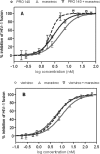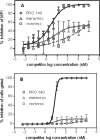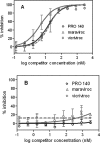Potent antiviral synergy between monoclonal antibody and small-molecule CCR5 inhibitors of human immunodeficiency virus type 1
- PMID: 17005807
- PMCID: PMC1610098
- DOI: 10.1128/AAC.00699-06
Potent antiviral synergy between monoclonal antibody and small-molecule CCR5 inhibitors of human immunodeficiency virus type 1
Abstract
The chemokine receptor CCR5 provides a portal of entry for human immunodeficiency virus type 1 (HIV-1) into susceptible CD4(+) cells. Both monoclonal antibody (MAb) and small-molecule CCR5 inhibitors have entered human clinical testing, but little is known regarding their potential interactions. We evaluated the interactions between CCR5 MAbs, small-molecule CCR5 antagonists, and inhibitors of HIV-1 gp120, gp41, and reverse transcriptase in vitro. Inhibition data were analyzed for cooperative effects using the combination index (CI) method and stringent statistical criteria. Potent, statistically significant antiviral synergy was observed between the CCR5 MAb PRO 140 and the small-molecule CCR5 antagonists maraviroc (UK-427,857), vicriviroc (SCH-D), and TAK-779. High-level synergy was observed consistently across various assay systems, HIV-1 envelopes, CCR5 target cells, and inhibition levels. CI values ranged from 0.18 to 0.64 and translated into in vitro dose reductions of up to 14-fold. Competition binding studies revealed nonreciprocal patterns of CCR5 binding by MAb and small-molecule CCR5 inhibitors, suggesting that synergy occurs at the level of receptor binding. In addition, both PRO 140 and maraviroc synergized with the chemokine RANTES, a natural ligand for CCR5; however, additive effects were observed for both small-molecule CCR5 antagonists and PRO 140 in combination with other classes of HIV-1 inhibitors. The findings provide a rationale for clinical exploration of MAb and small-molecule CCR5 inhibitors in novel dual-CCR5 regimens for HIV-1 therapy.
Figures



Similar articles
-
Multiple CCR5 conformations on the cell surface are used differentially by human immunodeficiency viruses resistant or sensitive to CCR5 inhibitors.J Virol. 2011 Aug;85(16):8227-40. doi: 10.1128/JVI.00767-11. Epub 2011 Jun 15. J Virol. 2011. PMID: 21680525 Free PMC article.
-
Molecular interactions of CCR5 with major classes of small-molecule anti-HIV CCR5 antagonists.Mol Pharmacol. 2008 Mar;73(3):789-800. doi: 10.1124/mol.107.042101. Epub 2007 Dec 20. Mol Pharmacol. 2008. PMID: 18096812
-
Cell surface expression of CCR5 and other host factors influence the inhibition of HIV-1 infection of human lymphocytes by CCR5 ligands.Virology. 2007 Aug 1;364(2):281-90. doi: 10.1016/j.virol.2007.02.022. Epub 2007 Apr 10. Virology. 2007. PMID: 17428518 Free PMC article.
-
[Viral entry as therapeutic target. Current situation of entry inhibitors].Enferm Infecc Microbiol Clin. 2008 Oct;26 Suppl 11:5-11. doi: 10.1016/s0213-005x(08)76557-1. Enferm Infecc Microbiol Clin. 2008. PMID: 19133215 Review. Spanish.
-
A pièce de resistance: how HIV-1 escapes small molecule CCR5 inhibitors.Curr Opin HIV AIDS. 2009 Mar;4(2):118-24. doi: 10.1097/COH.0b013e3283223d46. Curr Opin HIV AIDS. 2009. PMID: 19339950 Free PMC article. Review.
Cited by
-
Potent synergistic anti-human immunodeficiency virus (HIV) effects using combinations of the CCR5 inhibitor aplaviroc with other anti-HIV drugs.Antimicrob Agents Chemother. 2008 Jun;52(6):2111-9. doi: 10.1128/AAC.01299-07. Epub 2008 Mar 31. Antimicrob Agents Chemother. 2008. PMID: 18378711 Free PMC article.
-
Universal antiretroviral regimens: thinking beyond one-pill-once-a-day.Curr Opin HIV AIDS. 2017 Jul;12(4):343-350. doi: 10.1097/COH.0000000000000374. Curr Opin HIV AIDS. 2017. PMID: 28368868 Free PMC article. Review.
-
Maraviroc in the treatment of HIV infection.Drug Des Devel Ther. 2009 Feb 6;2:151-61. doi: 10.2147/dddt.s3474. Drug Des Devel Ther. 2009. PMID: 19920903 Free PMC article.
-
The critical need for alternative antiretroviral formulations, and obstacles to their development.J Infect Dis. 2011 Sep 1;204(5):669-74. doi: 10.1093/infdis/jir370. Epub 2011 Jul 25. J Infect Dis. 2011. PMID: 21788451 Free PMC article. No abstract available.
-
New antiretroviral inhibitors and HIV-1 drug resistance: more focus on 90% HIV-1 isolates?FEMS Microbiol Rev. 2023 Jan 16;47(1):fuac040. doi: 10.1093/femsre/fuac040. FEMS Microbiol Rev. 2023. PMID: 36130204 Free PMC article. Review.
References
-
- Alkhatib, G., C. Combadiere, C. C. Broder, Y. Feng, P. E. Kennedy, P. M. Murphy, and E. A. Berger. 1996. CC CKR5: a RANTES, MIP-1α, MIP-1β receptor as a fusion cofactor for macrophage-tropic HIV-1. Science 272:1955. - PubMed
-
- Allaway, G. P., K. L. Davis-Bruno, G. A. Beaudry, E. B. Garcia, E. L. Wong, A. M. Ryder, K. W. Hasel, M.-C. Gauduin, R. A. Koup, J. S. McDougal, and P. J. Maddon. 1995. Expression and characterization of CD4-IgG2, a novel heterotetramer which neutralizes primary HIV-1 isolates. AIDS Res. Hum. Retrovir. 11:533-539. - PubMed
-
- Baba, M., O. Nishimura, N. Kanzaki, M. Okamoto, H. Sawada, Y. Iizawa, M. Shiraishi, Y. Aramaki, K. Okonogi, Y. Ogawa, K. Meguro, and M. Fujino. 1999. A small-molecule, nonpeptide CCR5 antagonist with highly potent and selective anti-HIV-1 activity. Proc. Natl. Acad. Sci. USA 96:5698-5703. - PMC - PubMed
-
- Basavapathruni, A., C. M. Bailey, and K. S. Anderson. 2004. Defining a molecular mechanism of synergy between nucleoside and nonnucleoside AIDS drugs. J. Biol. Chem. 279:6221-6224. - PubMed
Publication types
MeSH terms
Substances
Grants and funding
LinkOut - more resources
Full Text Sources
Other Literature Sources
Research Materials
Miscellaneous

